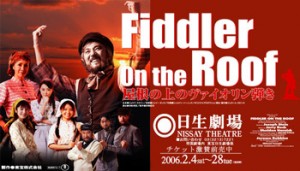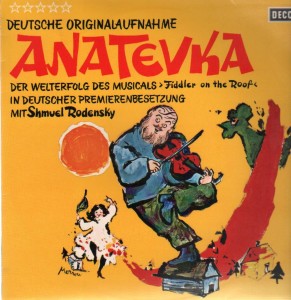Fifty Years of Fiddler on the Roof
Posted on September 20, 2014 at 8:00 am
 The Yiddish-language stories of Sholem Alechim, collected as Tevye the Dairyman and The Railroad Stories (Library of Yiddish Classics)
The Yiddish-language stories of Sholem Alechim, collected as Tevye the Dairyman and The Railroad Stories (Library of Yiddish Classics), inspired one of the most successful, influential, and widely performed Broadway musicals of all time, “Fiddler on the Roof,” which opened fifty years ago this week. It set the then-record of 3000 performances and still is listed as the 16th longest-running Broadway musical in history. There has been hardly a day since this story about a Jewish community in czarist Russia opened that it has not been performed somewhere around the world. Its songs, including “Sunrise, Sunset” and “If I Were a Rich Man,” have become standards, performed and recorded by singers around the world.
The play establishes its setting with the opening number, “Tradition,” where the fathers, mothers, sons, and daughters sing about the roles established for them by their culture and religion. But the theme of the play will be the pressure of modernity as all of the assumptions and beliefs of the community will be challenged.
The central character is Tevye (played by Zero Mostel on Broadway and the Israeli actor Topol in the movie
). He is a poor milkman with five daughters
 . Tradition would give Tevye the role of selecting husbands for his daughters based on what would be socially and economically advantageous. He approves of the widower butcher for his oldest daughter. But she challenges tradition by asking for his approval for her to marry the shy tailor she loves. Tevye must bend because he loves her and wants her to be happy. Seeing her in love makes him question for the first time whether his wife of 25 years, chosen for him, loves him. But his second daughter asks him to bend farther. She loves a hot-headed revolutionary, and she says they will marry whether Tevye approves or not. He is worried, but he gives them his blessing.
. Tradition would give Tevye the role of selecting husbands for his daughters based on what would be socially and economically advantageous. He approves of the widower butcher for his oldest daughter. But she challenges tradition by asking for his approval for her to marry the shy tailor she loves. Tevye must bend because he loves her and wants her to be happy. Seeing her in love makes him question for the first time whether his wife of 25 years, chosen for him, loves him. But his second daughter asks him to bend farther. She loves a hot-headed revolutionary, and she says they will marry whether Tevye approves or not. He is worried, but he gives them his blessing.
And then the third daughter asks him to bend further. She is in love with a non-Jew. Tevye says that is something he cannot accept. It shakes the foundations of his beliefs to even consider it. But not as much as they will be shaken by an anti-Semitic pogrom, with the Czar’s men all but destroying their village. The title of the play comes from the image of a musician precariously trying to maintain his balance and stay safely on a roof. The play ends with Tevye following millions of Europeans over the late 19th and early 20th century — immigrating to America, under the lamp held high for them by the Statue of Liberty.
Many years ago, my parents were visiting Tokyo and saw that a production of “Fiddler on the Roof” was on stage there. They bought tickets. Even though it was in Japanese, with Japanese actors, they recognized the story and music. And they enjoyed the enthusiastic response of the audience. When it was over, my father asked one of the Japanese audience members who spoke English why the play was so popular there. He smiled, “It’s very Japanese!” The details, including the style of the music, are very particular to one group. But the themes of balancing tradition with growing understanding about ourselves and the world, about struggles between parents and children, about what is best for the community and what is best for the individual, are universal.
